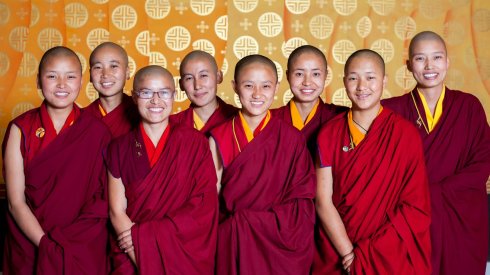A Tibetan Buddhist nunnery for equality in Yunnan

“The nunnery needs to be quiet, but when they go out, they can relax and sing loudly in the car. “ This is how the nuns of Tarpa Ling Buddhist Nunnery are described by outsiders.
The Tarpa Ling Nunnery is affiliated with the Dondrup Ling Temple, one of the 13 major temples in the Tibetan inhabited area of Yunnan Province. The nunnery has the most nuns in Yunnan Province, and worships Shakyamuni Buddha, Tsongkhapa, God of a Lion's Head, and other deities. The 120 nuns of the temple have an average age of 37; other than seven nuns who came from Sichuan and Nagri in Tibet, most nuns are from the Dechen Tibetan Autonomous Prefecture in Yunnan Province.
Yeshe Qutze, a 24-year-old nun at the nunnery, has been here for the last five years, said “It was my idea to become a nun. Buddha is in my heart, and I vowed that I will follow the Buddha Dharma. A monastic life is giving everything you have to the Buddha.”
The Tarpa Ling Nunnery is well-respected by locals for its strict rules. Usually, other than a few staffers who manage the daily affairs, all of the nuns spend their time studying. The nunnery has a tight schedule: morning homework at 6 am, sutra-reading at 7 am, class at 9 am, lunch and rest at noon, sutra debating at 2 pm, outside sutra-teaching for worshippers at 4 pm, dinner at 6 pm, sutra-reading at 7 pm, and rest at 9 pm. The nuns have one day off every ten days. They spend nine months of the year at the nunnery and visit their families for the other three.
In the two sutra classes, the nuns could study the five great shastras and other Tibetan Buddhist books. In the past few years, the nunnery has also added Chinese, English, and math classes. It is said that in the past, nuns were not allowed to touch artifacts nor study the five great shastras, but now they are allowed.

According to Lang Weiwei and other researchers from the Sichuan Province Ethnic Studies Institute, earnings from religious activities at Tibetan nunneries are far less than earnings from Lama temples. Most nuns focus on self-improvement and seek enlightenment for the next life; they seldom participate in religious ceremonies. Because they rarely have the opportunity to attain degrees in religious studies, they also “lack credentials for conducting the ceremonies,” leading to less social acceptance.
“The Dharma is infinite. There should be gender equality.” Said Tsering. Local religious agencies have tried to enable nuns to pass certification tests. Currently, there are nuns who have studied the five sutras for as long as 15 years. After another two to three years, they hope to take tests at the three major temples in Tibet and earn a degree from the Buddhist Academy of China.
The biggest challenge for the nunnery is the increasing demands on funding from more infrastructure needs. The nunnery cannot hold large-scale ceremonies yet, and could only recite sutras for worshippers during vacations. The offerings from worshippers are not enough to sustain all the nuns, many of whom still depend on financial help from their families or the government.

The 52-year-old Tsering Peichu is a resident of Benzilan Village in Dechen, where the nunnery is located. While working as the director of the Cultural Station at the village, he helped make Benzilan’s Guozhuang Dance a National Non-Material Cultural Artifact, and became a local icon as a result. Six years ago, he transferred to work at the Dondrup Ling, Tarpa Lingling, and Yunxian Temples. He hopes to improve the infrastructure-building and enable the Tarpa Ling nuns to focus on learning the sutra as well.
To Yeshe Qutze, the remote location of the nunnery is a “peaceful and harmonious place.” She said, “My dream is to study the Dharma really well and elevate my spirituality. I will also help everyone else and alleviate their suffering.”
The practice of Tibetan women ordained as nuns began in 8th century Tibet, after Buddhism was introduced to the region. When the first Tibetan Buddhist Temple the Samye Monastery was founded, a group of Tibetan youths shaved their heads and left for India to learn the Dharma. Soon after, some noble women, such as Molusi, Nyatri Tsenpo’s concubine, also became nuns.
Your Comment
Name E-mailRelated News
-
;
-
-

-
Siwa Nunnery & Kirti Monastery
Aba is known as the place where Tibetan Buddhism developed, and there are plenty of temples and monasteries in Aba that will make you stop in your tracks.
-
-
-
Nuns' modern life in Tibetan Buddhist nunnery
A pizza place in Shangri-la County is Tashi Yungdrung's, a buddhist nun, favorite dining spot in Yunnan province.
-
-
-
Nunnery's business sense a boon in modernizing Tibet
For evidence of how Tibet is modernizing and prospering, look no further than its religious institutions. Without compromising its Buddhist principles, regional capital Lhasa's Tsanggo Nunnery has incorporated secular practices to survive and prosper.
-
Based in Lhasa, Tibet Vista is a Tibet travel agency that specialized in Tibet permit, and Tibet tours for both private and group travelers at a local price!
•4 Days Lhasa City Group Tour from USD 460 •8 Days Everest Base Camp Group Tour from USD 850 •15 Days Mt.Kailash Group Tour from USD 1780 •2016 Tibet Train Tours from Beijing, Shanghai, Chengdu, Xining,etc










